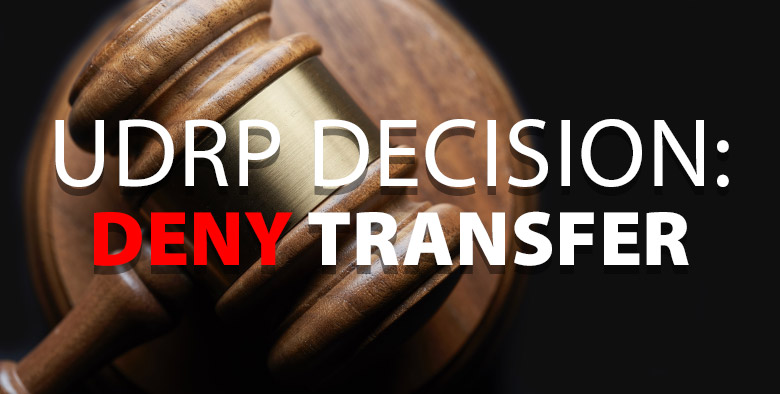The registrant of LiteBit.com, a domain name registered in 2000, could not have imagined the domain’s future use as a brand 18 years later.
And yet, 2525 Ventures B.V., of Netherlands, expected just that when they filed a UDRP at the WIPO to get the domain.
The Complainant in this case operates LITEBIT as a registered trademark in Benelux countries since 2018. The domain was acquired by the Respondent in 2005, due to its generic qualities; it’s made up from the words “lite” and “bit.”
In the response, the Respondent pointed out that it would have been impossible to be found guilty of a bad faith acquisition of the domain LiteBit.com, as the Complainant and their business did not exist.
It’s like needing a time machine to travel into the future, then back to the present and avoid acquiring the domain name. In April 2019, the Complainant instructed Sedo to approach the owner of the disputed domain name to offer an unspecified amount to buy the disputed domain name. The Respondent responded with a counteroffer of $287,500 dollars.
Final decision from a three member panel: deny transfer of the domain to the Complainant. Full details on this decision follow:

The domain transfer was denied.
Copyright © 2025 DomainGang.com · All Rights Reserved.WIPO Arbitration and Mediation Center
ADMINISTRATIVE PANEL DECISION
2525 Ventures B.V. v. Domain Administrator, Litebit.com c/o Whoisdefender.org / Domain Administrator, NetraCorp LLC / Domain Adminstrator, This Domain is c/o WhoisDefender.org
Case No. D2019-17991. The Parties
The Complainant is 2525 Ventures B.V., Netherlands, represented by JPR Advocaten Coöperatief U.A., Netherlands.
The Respondent is Domain Administrator, Litebit.com c/o Whoisdefender.org, New Zealand / Domain Administrator, NetraCorp LLC, United States of America (“United States”), represented by John Berryhill, Ph.d., Esq., United States.
2. The Domain Name and Registrar
The disputed domain name <litebit.com> is registered with TurnCommerce, Inc. DBA NameBright.com (the “Registrar”).
3. Procedural History
The Complaint was filed with the WIPO Arbitration and Mediation Center (the “Center”) on July 26, 2019. On July 26, 2019, the Center transmitted by email to the previous registrar of the disputed domain name a request for registrar verification in connection with the disputed domain name. On July 29, 2019, the previous registrar transmitted by email to the Center its verification response disclosing registrant and contact information for the disputed domain name which differed from the named Respondent and contact information in the Complaint. The Center sent an email communication to the Complainant on August 6, 2019 providing the registrant and contact information disclosed by the Registrar, and inviting the Complainant to submit an amendment to the Complaint. The Complainant filed an amended Complaint on August 9, 2019.
The Center verified that the Complaint together with the amended Complaint satisfied the formal requirements of the Uniform Domain Name Dispute Resolution Policy (the “Policy” or “UDRP”), the Rules for Uniform Domain Name Dispute Resolution Policy (the “Rules”), and the WIPO Supplemental Rules for Uniform Domain Name Dispute Resolution Policy (the “Supplemental Rules”).
In accordance with the Rules, paragraphs 2 and 4, the Center formally notified the Respondent of the Complaint, and the proceedings commenced on August 19, 2019. In accordance with the Rules, paragraph 5, the due date for Response was September 8, 2019. After granting the automatic four calendar day extension, the Response was filed with the Center September 12, 2019.
On September 13, 2019, the previous registrar informed the Center that it has transferred the disputed domain name to the management of the Registrar (i.e., specified in section 2 above). On the same date, the Center transmitted by email to the Registrar a request for registrar verification in connection with the disputed domain name. On September 17, 2019, the previous registrar transmitted by email to the Center its verification response.
The Center appointed Adam Taylor, Nick J. Gardner, and Frederick M. Abbott as panelists in this matter on October 8, 2019. The Panel finds that it was properly constituted. Each member of the Panel has submitted the Statement of Acceptance and Declaration of Impartiality and Independence, as required by the Center to ensure compliance with the Rules, paragraph 7.
4. Factual Background
The Complainant has used the name “LiteBit” to supply cryptocurrency services since 2013.
The Complainant owns Benelux trade mark no. 1022661 for the word LITEBIT, filed October 16, 2017, registered January 4, 2018, in class 36. The Complainant also owns European Union trade mark No. 018017493 for a logo incorporating the word LITEBIT filed January 31, 2019, registered May 31, 2019, in classes 36 and 42.
The disputed domain name was created on January 29, 2000, by a person other than the Respondent. The date when the Respondent acquired the disputed domain name is a key issue in the case and is discussed in detail in section 6.C below.
Since at least 2008, the disputed domain name has been used for a website with pay-per-click (“PPC”) links to a wide range of services including movie downloads and computer games. Since 2014, the PPC links included currency exchange and related services. After the Respondent became aware of the Complainant’s claim, the Respondent manually targeted the PPC links to topics relating to high speed Internet and optical fibre telecommunications.
The Complainant sent a cease and desist letter by email to the Respondent via the privacy service on April 25, 2019, as well as a chaser email on May 2, 2019, but received no response. The Complainant also unsuccessfully attempted to contact the Respondent via various other routes including via the monetisation service, Uniregistry.
In around April 2019, the Complainant instructed Sedo to approach the owner of the disputed domain name to offer an unspecified amount to buy the disputed domain name. The Respondent responded with a counteroffer of USD 287,500.
5. Parties’ Contentions
A. Complainant
The following is a summary of the Complainant’s contentions:
The Complainant owns “tradename” rights under Dutch law in addition to its registered trade marks. The disputed domain name is identical to the Complainant’s trade marks.
The Complainant is well-known in the cryptocurrency market.
The Respondent lacks rights and legitimate interests in the disputed domain name.
The Respondent does not plan to use the disputed domain name for a legitimate commercial offering of goods or services.
The Respondent is not known by the disputed domain name.
The disputed domain name is being used only to offer it for sale for a disproportionate sum and to redirect users.
The Respondent uses a privacy / proxy service to conceal its true identity.
The disputed domain name has been used for PPC links as well as “the possibility to redirect to competitors” of the Complainant. Such use of the disputed domain name is illegitimate.
Given the fame of the Complainant and its position in the cryptocurrency market, the Complainant’s interests in the disputed domain name are “more legitimate” than those of the Respondent.
The disputed domain name was registered and is being used in bad faith.
There is a presumption of bad faith as the disputed domain name is identical to the Complainant’s trade marks.
The following constitute bad faith on the part of the Respondent:
– the Respondent’s failure to comply with the Complainant’s cease and desist letter and the Respondent’s continued offering of the disputed domain name for sale thereafter;
– the Respondent’s offer to sell the disputed domain name for USD 287,500, which exceeds the usual registration costs of a domain name;
– the use of the disputed domain name for automatically generated PPC links, which take undue advantage of the Complainant’s well-known trade marks;
– the failure of the Respondent to provide a credible, evidence-backed rationale for registering the disputed domain name; and
– the Respondent’s use of a privacy service and false contact details including an inactive phone number.The Respondent was well-aware of the Complainant’s trade mark rights, which is shown by the fame of the Complainant in the European Union, its prominence in Google search results, the appearance of the Complainant’s corporate name within the disputed domain name and the Complainant’s communications to the Respondent, which included a counter-offer by the Respondent.
There is a likelihood of confusion with the Complainant’s trade marks which may damage the Complainant, e.g., if the Complainant’s customers or potential customers assume that the Complainant owns the disputed domain name and send emails to the Respondent by mistake, or visit the website at the disputed domain name and think that the Complainant has gone out of business or search on the Respondent’s website for the Complainant’s services and find competitors. Many users of social media and cryptocurrency websites in different countries, including users knowledgeable about cryptocurrency, have wrongly assumed that the Complainant owns the disputed domain name and mistakenly linked to the Respondent’s website as a result. The Respondent acquired the disputed domain name after much of the above-mentioned confusion had occurred. In these circumstances, it can be assumed that the Respondent acquired the disputed domain name to create a likelihood of confusion with the Complainant’s trade mark. Such confusion will continue for as long as the Respondent uses the disputed domain name.
The disputed domain name was acquired by the current owner on December 29, 2018, when the registrar changed to “NetraCorp” or, at the earliest, on April 18, 2016, when the IP address of the disputed domain name last changed. Either way, by the time that the Respondent acquired the disputed domain name, the Complainant possessed trade mark rights, it had become well-known and confusion had occurred.
The disputed domain name has been used for PPC links relating to money exchange services after the Complainant became well-known for those services, specifically cryptocurrency exchanges. The disputed domain name is therefore being used in the same market as that in which the Complainant operates. It is also being used for complementary services, because faster broadband services can benefit those involved in cryptocurrency trading and mining services.
B. Respondent
The following is a summary of the Respondent’s contentions:
The Respondent acquired the disputed domain name in September 2005, at least eight years before the Complainant acquired any trade mark rights. The Respondent selected the disputed domain name in the belief that it would have a commercial value as a combination of two short dictionary words: “lite” and “bit”.
The Respondent possesses legitimate rights and interests in the disputed domain name on the basis of its use of the disputed domain name for a bona fide purpose and, also, seniority.
Since registering the disputed domain name, the Complainant has used it for automated PPC links relating to the disputed domain name itself, which was entirely legitimate. As of 2005, the Respondent was free to use the disputed domain name however it wished. The Complainant’s later promotion of its mark may have altered the PPC results. If so, that was a consequence of the Complainant choosing to launch a mark corresponding to an existing PPC-parked domain name. Such results occurred prior to any notice or duty of notice on the Respondent. After becoming aware of the Complaint, and although it had no duty to do so, the Respondent manually targeted the disputed domain name to topics suggested directly by the terms in the disputed domain name and which do not relate to the Complainant’s services.
The Respondent has not registered or used the disputed domain name in bad faith.
Bad faith registration cannot be found where the domain name predates the claimed rights at issue apart from a narrow form of anticipatory bad faith which does not apply here.
The Complainant is wrong to claim that a change of hosting IP address means that the registrant has changed. Also, there was no change of registrar in 2018, merely a switch from the registrar trading name to its corporate name. The registrar ID for the disputed domain name has not changed since 2005.
Neither use of a privacy service nor use of a domain name monetisation service for a domain name registered in 2005 establishes bad faith for a trade mark which the Complainant does not claim to have begun using until 2013.
The Respondent’s non-receipt of communications from the Complainant does not establish bad faith registration of the disputed domain name in 2005. The Respondent aggressively filters spam emails with attachments from unknown senders.
The Respondent’s “go away” offer to sell the disputed domain name in response to the Sedo approach in 2019 does not establish an intent by the Respondent to sell the disputed domain name to the non-existent Complainant in 2005.
6. Discussion and Findings
Under the Policy, the Complainant is required to prove on the balance of probabilities that:
– the disputed domain name is identical or confusingly similar to a trade mark in which the Complainant has rights;
– the Respondent has no rights or legitimate interests in respect of the disputed domain name; and
– the disputed domain name has been registered and is being used in bad faith.A. Identical or Confusingly Similar
The Complainant has established rights in the mark LITEBIT by virtue of its registered trade marks as well as unregistered trade mark rights deriving its use of that name since 2013.
Disregarding the domain name suffix, the disputed domain name is identical to the Complainant’s trade mark.
The Panel therefore finds that the Complainant has established the first element of paragraph 4(a) of the Policy.
B. Rights or Legitimate Interests
It is unnecessary to consider this element in view of the Panel’s conclusion under the third element below.
C. Registered and Used in Bad Faith
The Complainant must establish both registration and use in bad faith.
Section 3.8.1 of the WIPO Overview of WIPO Panel Views on Selected UDRP Questions, Third Edition (“WIPO Overview 3.0”) states that, subject to certain limited scenarios where a domain name was registered in anticipation of nascent trade mark rights (not applicable here), panels will not normally find bad faith on the part of the respondent where a respondent registers a domain name before the complainant’s trade mark rights accrue.
Here, the Complainant claims trade mark rights dating from 2013 and asserts that the Respondent acquired the disputed domain name after this — in 2018, or by 2016 at the earliest.
However, the Respondent says that it acquired the disputed domain name from its previous owner as long ago as 2005. In support, the Respondent has produced an initial transfer confirmation email dated 2005 describing “NetraCorp LLC” as the “Customer” and an annual WhoIs accuracy reminder email dated 2006, describing the same entity as the “Registrant”. And, on July 29, 2019, the registrar verification response issued following the filing of this Complaint stated that “NetraCorp LLC” was the registrant of the disputed domain name.
While these three communications were sent by the Respondent wearing its different hat as the registrar of the disputed domain name, the Panel has no reason to doubt their authenticity.
This evidence satisfies the Panel that, on the balance of probabilities, the Respondent (NetraCorp LLC) has indeed been the controller of the disputed domain name since at least 2005, as well as being the registrar.
The Panel understands that the constant privacy service changes, plus the fact that the Respondent was also the registrar, may have created a confusing picture for the Complainant.
The Complainant’s claim that the Respondent acquired the disputed domain name on December 29, 2018, is based on an alleged registrar change which the Complainant says occurred on or around that date. The Complainant is apparently referring to a switch from “Global Internet” to “NetraCorp LLC dba Global Internet”. It is far from clear that such a change did occur as all of the DomainTools archive WhoIs printouts up to and including July 25, 2019, refer to the registrar as “Global Internet” — though a “Domain Profile” dated July 25, 2019, does indeed name “NetraCorp LLC dba Global Internet” as the registrar. In any case, as the latter formulation makes clear, “Global Internet” is simply a trading name of NetraCorp LLC and the registrar identity number, i.e., the “IANA ID”, has remained unchanged throughout.
It is therefore reasonably clear that no registrar change occurred around the time claimed by the Complainant 1 but, even if it had, that would not have helped the Complainant given the evidence that the Respondent has been the controller of the disputed domain name since 2005.
Similarly, the Panel does not consider that the change of IP address in 2016 changes the assessment of the chain of ownership / control of the disputed domain name.
Given the Panel’s conclusion that the Respondent acquired the disputed domain name in 2005, before the Complainant’s first claimed use of the disputed domain name, the Respondent could not have registered the disputed domain name in bad faith for the purposes of the Policy. It is therefore unnecessary for the Panel to consider the various other matters raised by the Complainant relating to alleged bad faith, such as the alleged likely or actual confusion on the part of the Complainant’s customers.
For the above reasons, the Panel finds that the Complainant has failed to establish the third element of paragraph 4(a) of the Policy.
7. Decision
For the foregoing reasons, the Complaint is denied.
Adam Taylor
Presiding PanelistNick J. Gardner
PanelistFrederick M. Abbott
Panelist
Date: October 22, 20191 For completeness, the Panel notes that on September 9, 2019, i.e., after the Complaint was filed, the registrar of the disputed domain name was changed to the new entity identified in section 2 of this decision. The Respondent informed the Center that the reason for this was because the Respondent had decided to discontinue its ICANN accreditation and to transfer all of the domains under its management in bulk to the Registrar. In its verification response dated September 17, 2019, the Registrar identified the underlying registrant not as the Respondent but as the same privacy service through which the disputed domain name had been held at the time when the Complaint was filed. While it is not clear why this is so, none of these matters cause the Panel to alter its conclusion that the Respondent has been the underlying controller of the disputed domain name from 2005 to date.












